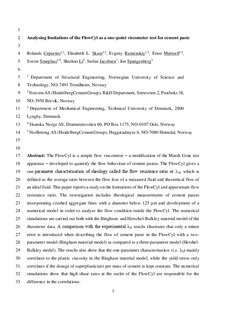| dc.contributor.author | Cepuritis, Rolands | |
| dc.contributor.author | Skare, Elisabeth Leite | |
| dc.contributor.author | Ramenskiy, Evgeny | |
| dc.contributor.author | Mørtsell, Ernst | |
| dc.contributor.author | Smeplass, Sverre | |
| dc.contributor.author | Li, Shizhao | |
| dc.contributor.author | Jacobsen, Stefan | |
| dc.contributor.author | Spangenberg, Jon | |
| dc.date.accessioned | 2019-06-13T08:23:21Z | |
| dc.date.available | 2019-06-13T08:23:21Z | |
| dc.date.created | 2019-05-25T13:26:05Z | |
| dc.date.issued | 2019 | |
| dc.identifier.citation | Construction and Building Materials. 2019, 218 333-340. | nb_NO |
| dc.identifier.issn | 0950-0618 | |
| dc.identifier.uri | http://hdl.handle.net/11250/2600685 | |
| dc.description.abstract | The FlowCyl is a simple flow viscometer – a modification of the Marsh Cone test apparatus – developed to quantify the flow behaviour of cement pastes. The FlowCyl gives a one-parameter characterisation of rheology called the flow resistance ratio or λQ, which is defined as the average ratio between the flow loss of a measured fluid and theoretical flow of an ideal fluid. This paper reports a study on the limitations of the FlowCyl and appurtenant flow resistance ratio. The investigation includes rheological measurements of cement pastes incorporating crushed aggregate fines with a diameter below 125 µm and development of a numerical model in order to analyse the flow condition inside the FlowCyl. The numerical simulations are carried out both with the Bingham- and Herschel-Bulkley material model of the rheometer data. A comparison with the experimental λQ results illustrates that only a minor error is introduced when describing the flow of cement paste in the FlowCyl with a two-parameter model (Bingham material model) as compared to a three-parameter model (Hershel-Bulkley model). The results also show that the one-parameter characterisation (i.e. λQ) mainly correlates to the plastic viscosity in the Bingham material model, while the yield stress only correlates if the dosage of superplasticizer per mass of cement is kept constant. The numerical simulations show that high shear rates at the outlet of the FlowCyl are responsible for the difference in the correlations. | nb_NO |
| dc.language.iso | eng | nb_NO |
| dc.publisher | Elsevier | nb_NO |
| dc.rights | Attribution-NonCommercial-NoDerivatives 4.0 Internasjonal | * |
| dc.rights.uri | http://creativecommons.org/licenses/by-nc-nd/4.0/deed.no | * |
| dc.title | Analysing limitations of the FlowCyl as a one-point viscometer test for cement paste | nb_NO |
| dc.type | Journal article | nb_NO |
| dc.type | Peer reviewed | nb_NO |
| dc.description.version | acceptedVersion | nb_NO |
| dc.source.pagenumber | 333-340 | nb_NO |
| dc.source.volume | 218 | nb_NO |
| dc.source.journal | Construction and Building Materials | nb_NO |
| dc.identifier.doi | https://doi.org/10.1016/j.conbuildmat.2019.05.127 | |
| dc.identifier.cristin | 1700238 | |
| dc.description.localcode | © 2019. This is the authors’ accepted and refereed manuscript to the article. Locked until 25 May 2021 due to copyright restrictions. This manuscript version is made available under the CC-BY-NC-ND 4.0 license http://creativecommons.org/licenses/by-nc-nd/4.0/ | nb_NO |
| cristin.unitcode | 194,64,45,0 | |
| cristin.unitname | Institutt for konstruksjonsteknikk | |
| cristin.ispublished | true | |
| cristin.fulltext | original | |
| cristin.qualitycode | 2 | |

